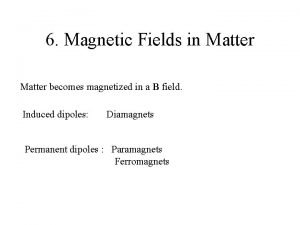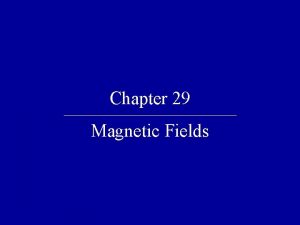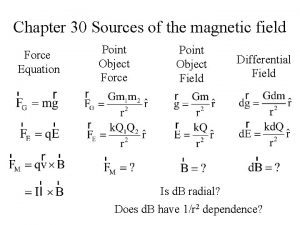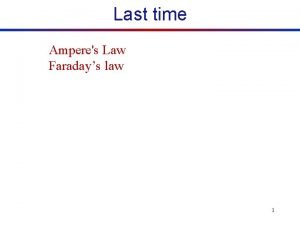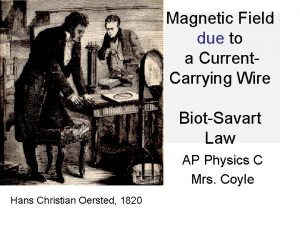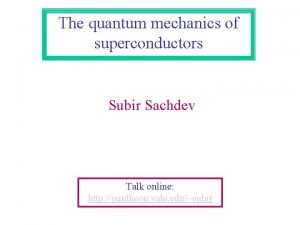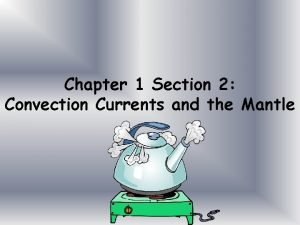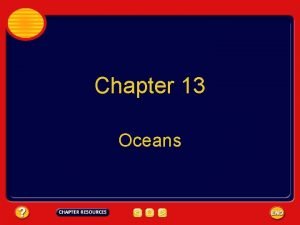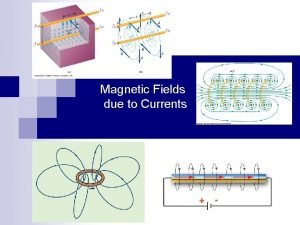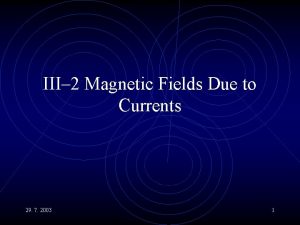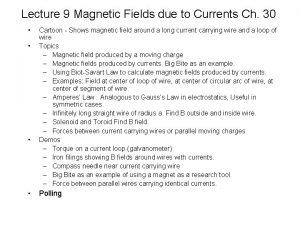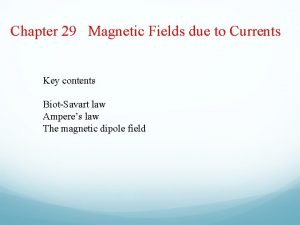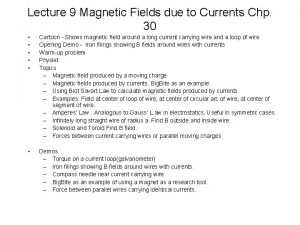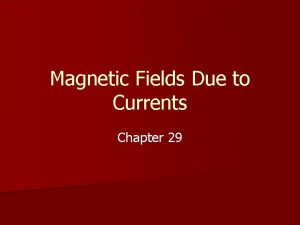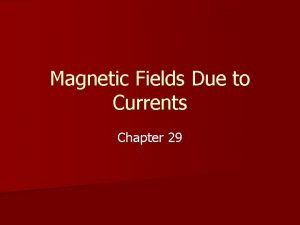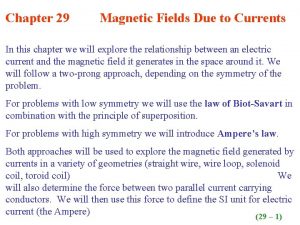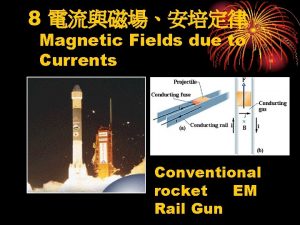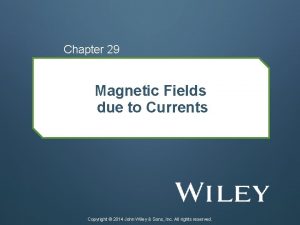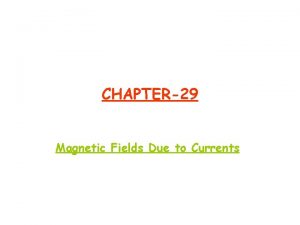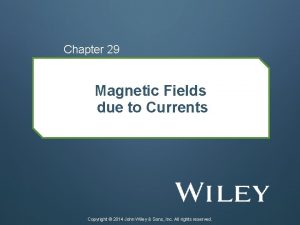III 2 Magnetic Fields Due to Currents 25






















- Slides: 22

III– 2 Magnetic Fields Due to Currents 25. 10. 2021 1

Main Topics • • Forces on Moving Electric Charges Biot-Savart Law Ampere’s Law. Calculation of Some Magnetic Fields. 25. 10. 2021 2

Forces on Electric Currents III • From the formula describing force on electric currents the units can be derived. • The SI unit for the magnetic intensity B is 1 Tesla, abbreviated as T, 1 T = 1 N/Am • Some older are units still commonly used for instance 1 Gauss: 1 G = 10 -4 T 25. 10. 2021 3

Forces on Electric Currents IV • Now, we can qualitatively show that two parallel currents will attract and the force will be in the straight line which connects these currents. This seems to be similar to a force between two point charges but now the force is the result of a double vector product as we shall see very soon. 25. 10. 2021 4

Forces on Moving Electric Charges I • Since currents are in reality moving charges it can be expected that all what is valid for interaction of magnetic fields with currents will be valid also for moving charges. • The force of a magnetic field B acting on a charge q moving by a velocity v is given by the Lorentz formula: F = q(v x B) 25. 10. 2021 5

Forces on Moving Electric Charges II • Lorentz force is in fact part of a more general formula which includes both electric and magnetic forces: F = q[E + (v x B)] • This relation can be taken as a definition of electric and magnetic forces and can serve as a starting point to study them. 25. 10. 2021 6

Forces on Moving Electric Charges III • Lorentz force is a central issue in whole electromagnetism. We shall return to it by showing several examples. Moreover we shall find out that it can be used as a basis of explanation of almost all magnetic and electromagnetic effects. • But at this point we need to know how are magnetic fields created quantitatively. 25. 10. 2021 7

Biot-Savart Law I • There are many analogies between electrostatic and magnetic fields and of course a question arises whether some analog of the Coulomb’s law exists, which would describe how two short pieces of wires with current would affect themselves. It exists but it is too complicated to use. For this reason the generation and influence of magnetic fields are separated. 25. 10. 2021 8

Biot-Savart Law II • All what is necessary to find the mutual forces of two macroscopic wires of various sizes and shapes with currents is to employ the principle of superposition, which is valid in magnetic fields as well and integrate. • It is a good exercise to try to make a few calculations but we do something better! 25. 10. 2021 9

Ampère’s Law • As in electrostatics also in magnetism a law exists which can considerably simplify calculations in cases of a special symmetry and can be used to clarify physical ideas in many important situations. • It is the Ampères law which relates the line integral of B over a closed path with currents which are surrounded by the path. 25. 10. 2021 10

Magnetic Field Due to a Straight Wire I • As it is the case with using the Gauss’ law, we have to find a path which is tangential to B everywhere and on which the magnitude of B would be constant. So it must be a special field line. Then we can move B out of the integral, which is then simply the length of the path. 25. 10. 2021 11

Magnetic Field Due to a Straight Wire II • Let us have a straight wire with current I. • We expect B(r) and axial symmetry where the wire is naturally its axis. The field lines are circles and our path will be a circle with the radius r equal to the distance where we want to find the field. Then simply: 2 r B(r) = 0 I/2 r 25. 10. 2021 12

Magnetic Field Due to a Straight Wire III • So the vectors of the magnetic induction B are tangents to circles centered on the wire, which thereby are the field lines, and the magnitude of B decreases with the first power of the distance. It is similar as with the electrostatic field of an straight, infinite and uniformly charged wire. 25. 10. 2021 13

Force Between Two Straight Wires I • Let us have two straight parallel wires in which currents I 1 and I 2 flow in the same direction separated by a distance d. • First, we can find the directions and then simply deal only with the magnitudes. It is convenient to calculate a force per unit length. F/l = 0/2 I 1 I 2/d 25. 10. 2021 14

Force Between Two Straight Wires II • This is used for the definition of 1 ampere: 1 ampere is a constant current which, if maintained in two straight parallel conductors of infinite length, of negligible cross section, and placed 1 meter apart in vacuum, would produce between these conductors a force equal to 2 10 -7 N per meter of length. 25. 10. 2021 15

Homework • No homework! 25. 10. 2021 16

Things to read • Chapter 28 – 1, 2, 3, 4, 6 25. 10. 2021 17

Magnetic interaction of two currents I Let us have two currents I 1 and I 2 flowing in two pieces of wire dl 1(r 1) and dl 2(r 2). Then the force acting on the second piece due to the first piece, can be described by: This very general formula covers almost all the magnetism physics but would be hard to 25. use 10. 2021 18 in practice.

Magnetic interaction of two currents II That is the reason why it is divided into the formula using the field (we already know): and the formula to calculate the field, which is the Biot-Savart law: 25. 10. 2021 19

Magnetic interaction of two currents III If we realize that: is a unit vector pointing in the direction from the first current r 1 to the second one r 2, we se that magnetic forces decrease also with the second power of the distance. 25. 10. 2021 20

Magnetic interaction of two currents IV The “scaling” constant 0 = 4 10 -7 Tm/A is called the permeability of vacuum or of free space. Some authors don’t use it since it is not an independent parameter of the Nature. It is related to the perimitivity of vacuum 0 and the speed of light c by: 25. 10. 2021 ^ 21

Ampère’s Law Let us have none, two ore more wires with currents I 1, I 2 … then: • All the current must be added but their polarity must be taken into account ! 25. 10. 2021 ^ 22
 Electric currents and magnetic fields
Electric currents and magnetic fields Electric currents and magnetic fields
Electric currents and magnetic fields What is deep current
What is deep current Red fields
Red fields Lesson outline lesson 1 magnets and magnetic fields
Lesson outline lesson 1 magnets and magnetic fields Magnetic fields in matter
Magnetic fields in matter Lesson quiz 29-1
Lesson quiz 29-1 Learning: module 26: magnetic forces and fields
Learning: module 26: magnetic forces and fields Hamlet act iii scene ii
Hamlet act iii scene ii F=i(lxb)
F=i(lxb) Types of ferrites
Types of ferrites Weber unit of magnetic flux
Weber unit of magnetic flux Magnetic moment and magnetic field relation
Magnetic moment and magnetic field relation Magnetic field due to a curved wire segment
Magnetic field due to a curved wire segment Energy of magnetic field formula
Energy of magnetic field formula Magnetic field at point o will be
Magnetic field at point o will be Procedural vs substantive due process
Procedural vs substantive due process Slidetodoc
Slidetodoc Due piccole sfere identiche sono sospese a due punti p e o
Due piccole sfere identiche sono sospese a due punti p e o Quadrilateri con due lati paralleli
Quadrilateri con due lati paralleli Persistent currents
Persistent currents Convection currents definition
Convection currents definition Cold peruvian current
Cold peruvian current





